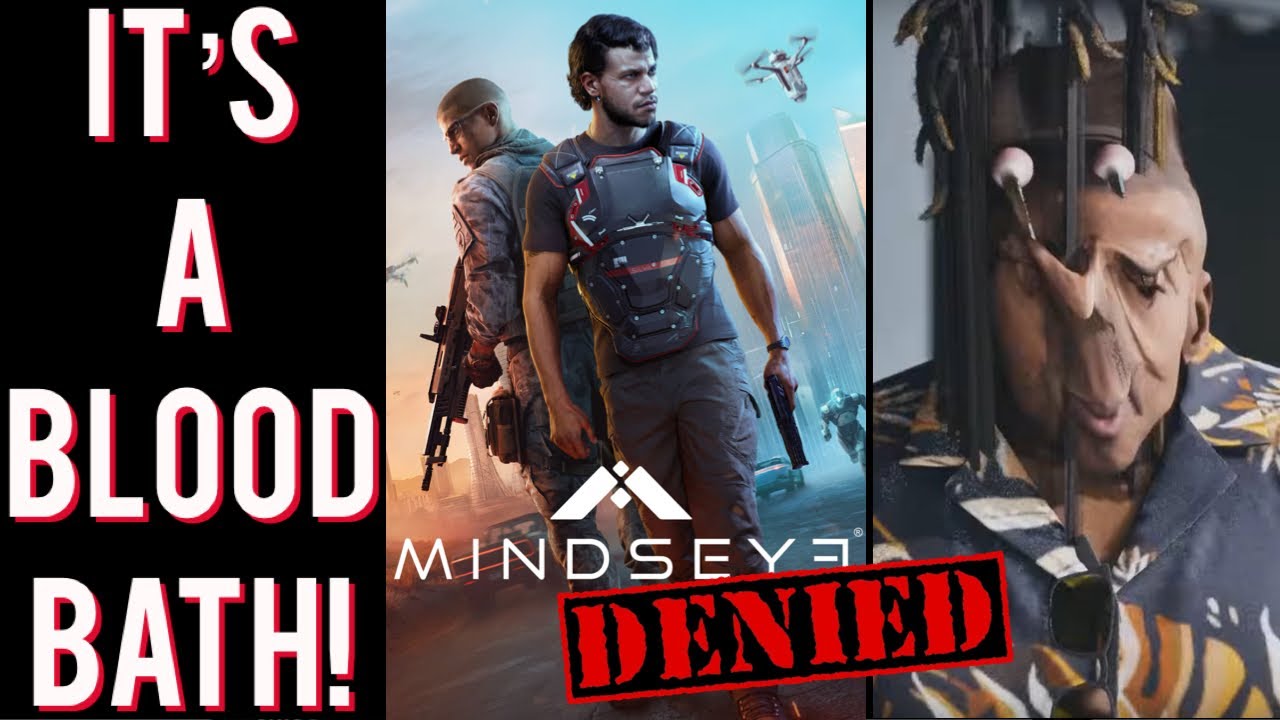MindsEye’s Launch Is a TOTAL Disaster! 😱
Why did MindsEye crash and burn?
The CEO blames “paid bad actors.”
Players point to bugs and glitches.
Who’s really at fault here?
Click to unravel the gaming chaos! 👇

The launch of MindsEye, a narrative-driven action-adventure game from Build a Rocket Boy, was meant to mark the triumphant debut of a studio led by former Grand Theft Auto visionary Leslie Benzies. Released on June 10, 2025, for PlayStation 5, Xbox Series X/S, and PC, the game instead became a cautionary tale of unmet expectations. Plagued by bugs, crashes, and performance issues, MindsEye earned a “Mostly Negative” rating on Steam and prompted PlayStation to issue rare refunds, drawing comparisons to Cyberpunk 2077’s infamous 2020 debacle. Amid the chaos, co-CEO Mark Gerhard sparked controversy by claiming “bad actors” were paid to sabotage the game’s reception, a narrative amplified by X posts like @YellowFlashGuy’s “Your FAULT it failed!” This article examines the launch, Gerhard’s allegations, and the broader implications for Build a Rocket Boy and the gaming industry, drawing on reports and critical analysis.
A Launch Gone Wrong: The Scale of the Disaster
MindsEye promised a cinematic, 15-hour thriller set in the near-futuristic city of Redrock, blending GTA-style mechanics with a linear story about Jacob Diaz, a former soldier with a mysterious neural implant. Developed by Build a Rocket Boy and published by IO Interactive (Hitman), the game boasted high-octane driving, tactical combat, and a user-generated content system tied to the studio’s Everywhere platform. However, its launch on June 10 was marred by technical failures. Steam reviews, sitting at 60% negative, cite crashes, stuttering, and “horrifying” glitches, such as NPCs ragdolling into grotesque limb tangles or cars floating in midair. Social media clips, shared by users like @NikTekOfficial on X, showcase stuttering gameplay and AI malfunctions, branding the game “unplayable.”
The fallout was swift. PlayStation approved refunds, a rare move reminiscent of Cyberpunk 2077’s delisting, while Xbox players faced a delayed day-one patch. Build a Rocket Boy canceled sponsored streams, including one with streamer CohhCarnage, who was notified mid-load to “reschedule” due to the game’s state. Kotaku reported streamer DarkViperAU struggling to promote the game without laughing, highlighting the embarrassment. By June 13, Steam’s concurrent player count peaked at a meager 3,302, a stark contrast to expectations for a $60 AAA title. Build a Rocket Boy issued a statement on Discord, admitting they were “heartbroken” and identifying a memory leak affecting 1 in 10 players as the primary crash culprit, with a hotfix promised by mid-June.
The CEO’s Conspiracy: Paid “Bad Actors”?
Mark Gerhard, co-CEO of Build a Rocket Boy, made headlines weeks before launch by claiming negative previews were part of a “concerted effort” to “trash the game and the studio.” In a Discord Q&A, he responded “100%” to a user asking if critics were paid, suggesting bots and financed actors were targeting the game. He hinted at a specific entity—possibly Rockstar Games, given Benzies’ legal history with them—without naming names, adding a laughing emoji to his comments. These claims, reported by IGN and Eurogamer, were met with skepticism, especially after publisher IO Interactive’s CEO, Hakan Abrak, stated, “I don’t believe that. The game should speak for itself.”
Post-launch, Gerhard’s narrative persisted, with X posts like @LegacyKillaHD accusing the studio of blaming “paid bots” instead of addressing the game’s flaws. The allegations stem from negative previews in May 2025, where YouTubers described MindsEye as a “broken mess” with stiff driving and shallow enemy encounters. Gerhard’s refusal to retract his claims, even when pressed on Discord, fueled speculation that he was deflecting from internal issues. Some fans, like @DavyJonesRJ on X, interpreted his comments as accusing Rockstar, citing Benzies’ 2016 lawsuit against his former employer over unpaid royalties. However, no evidence supports the sabotage claim, and IO Interactive’s rebuttal suggests it was a defensive tactic rather than a substantiated accusation.
Internal Turmoil: A Studio in Crisis
The launch troubles were compounded by Build a Rocket Boy’s internal struggles. Just one week before release, Chief Legal Officer Riley Graebner and Chief Financial Officer Paul Bland resigned, raising red flags about the studio’s stability. Eurogamer reported the departures via LinkedIn updates, noting their timing was “highly unusual” for a major launch. Former developers, in Glassdoor reviews rated at 2.1/5, described a toxic work environment plagued by crunch, political conflicts, and “toxic executives.” These accounts, covered by Tech4Gamers, suggest MindsEye’s issues were rooted in development mismanagement long before launch.
The studio’s decision to withhold review codes from media outlets like Polygon and Eurogamer further damaged trust. While YouTubers received hands-off preview access, their negative feedback prompted Gerhard’s conspiracy claims. X user @Grummz noted the studio’s high funding—bolstered by Benzies’ GTA pedigree—set lofty expectations, making the lack of polish unforgivable. The absence of review codes, coupled with a focus on sponsored streams, suggests Build a Rocket Boy knew the game wasn’t ready but pushed for release, possibly due to financial pressures.
The Game Itself: Ambitious but Unpolished
MindsEye’s core concept was ambitious: a linear, story-driven thriller with GTA-inspired mechanics, set in a pseudo-open world akin to Mafia: Definitive Edition. IGN’s preview described Redrock as a Las Vegas-inspired tech hub, with protagonist Jacob Diaz uncovering a conspiracy via missions involving driving, shooting, and drone-based tactics. The game’s user-generated content system, tied to Everywhere, allowed players to create missions, drawing comparisons to “AAA Minecraft.” However, reviews criticized its execution. GamesRadar+ praised the score but slammed the “bland” story and mechanics, while IGN’s Luke Reilly called it “unfinished” due to technical issues.
PC Gamer’s early impressions noted stable performance on older hardware but criticized the linear structure and repetitive cutscene-action loop, which clashed with the promised open-world vibe. Side missions, accessed via portals, felt tacked on, and the narrative lacked a unique hook, with themes of AI and greed feeling generic. Clips of “eldritch” glitches—NPCs contorting unnaturally or cars merging—went viral, overshadowing the game’s cinematic aspirations. Reddit’s r/gaming community called the launch an “unmitigated disaster,” with 706 upvotes on a post detailing “horrifying” bugs.
Industry Context: The Pressure of AAA Expectations
MindsEye’s failure reflects broader challenges in the gaming industry, where AAA titles face intense scrutiny. The $60 price tag and Benzies’ GTA legacy set expectations sky-high, but Build a Rocket Boy’s inexperience as a new studio likely contributed to the missteps. Reddit user u/Roids-in-my-vains argued that content creators amplify negativity for engagement, but the game’s issues—crashes, poor AI, and 30fps console lock—were undeniable. The comparison to Cyberpunk 2077 is apt: both games launched with hype but crumbled under technical flaws, though MindsEye lacks the established fanbase to weather the storm.
The studio’s marketing, promising to “revolutionize gaming,” backfired when gameplay trailers showed dated visuals and stiff mechanics. X posts from @eurogamer and @InsiderGamingIG highlight the disconnect between Build a Rocket Boy’s bold claims and the reality of a “mediocre” product. The decision to tie MindsEye to Everywhere, a free-to-play platform, may have stretched resources, with Reddit speculating that funding was “burnt up” on cutscenes and NFTs, though no evidence confirms the latter.
Can Build a Rocket Boy Recover?
Build a Rocket Boy’s response has been proactive but insufficient. The promised hotfix, addressing the memory leak, AI, and animations, is a step, but players on X and Reddit fear it’s “too little, too late.” The studio’s apology on Discord emphasized gratitude but didn’t address Gerhard’s conspiracy claims, which continue to erode credibility. IO Interactive’s hands-off stance suggests they’re distancing themselves from the PR fallout. With refunds flowing and sponsored streams canceled, MindsEye risks becoming a cautionary tale.
For recovery, Build a Rocket Boy must prioritize transparency. A clear roadmap, as outlined for June with performance patches and difficulty rebalancing, is a start, but regaining trust requires addressing internal issues like crunch and executive turnover. Benzies’ reputation gives the studio a chance to rebound, but Everywhere’s success now hinges on MindsEye’s lessons. The industry has seen comebacks—No Man’s Sky and Cyberpunk 2077 rebuilt goodwill through updates—but MindsEye’s niche appeal and lack of pre-existing hype make this an uphill battle.
Conclusion: Whose Fault Is It?
Gerhard’s claim of “bad actors” is a distraction from MindsEye’s core issues: a rushed launch, technical shortcomings, and mismanaged expectations. While it’s possible bots amplified negativity, as seen in other gaming controversies, no evidence supports a paid campaign, and the game’s documented bugs speak louder than any conspiracy. Build a Rocket Boy’s internal chaos—executive exits, toxic workplace allegations, and inadequate marketing—set the stage for failure. The gaming community, from Reddit to X, isn’t rooting against Benzies; they’re frustrated by a studio that overpromised and underdelivered.
MindsEye’s launch is a reminder that even veteran developers can stumble under AAA pressure. For Build a Rocket Boy, the path forward lies in fixing the game and rebuilding trust, not pointing fingers. As players watch for patches, the industry watches to see if this is a one-off flop or a sign of deeper troubles for a once-promising studio.





